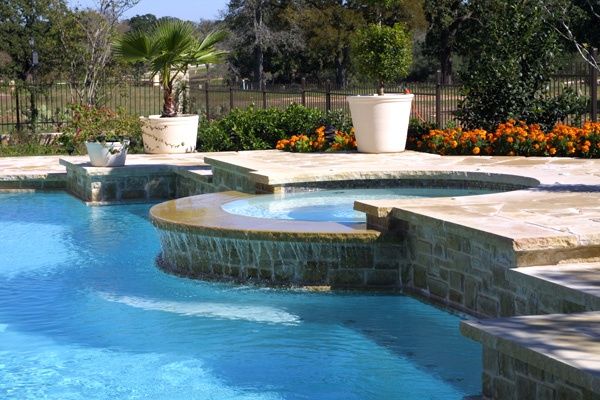
Pool Placement - How to Choose the Right Location for Your Pool
When planning for a new swimming pool, one of the most crucial decisions you’ll make outside of selecting the best pool builder in Round Rock, TX is where to place it in your backyard. The location of your pool not only impacts the overall aesthetics of your outdoor space but also influences its functionality, safety, and long-term enjoyment.
Selecting the right spot requires a thoughtful approach, considering factors like sun exposure, privacy, and safety, as well as local regulations and potential construction obstacles.
Let's look at the key elements that go into choosing the perfect location for your pool and how you can avoid common mistakes that may affect the pool’s usability and long-term maintenance.
The Importance of Sun Exposure, Privacy, and Safety
The position of your pool can make all the difference in how enjoyable and functional it is. Let's break down how sun exposure, privacy, and safety influence this decision.
1. Maximizing Sun Exposure for Optimal Use
One of the first things to consider is the amount of sun exposure the pool will receive. A pool that is positioned in an area with full or partial sunlight is ideal because it helps keep the water warm and reduces the need for excessive heating, which can increase energy costs.
When choosing the spot, observe how the sun moves across your yard throughout the day. Aim to place the pool in a location that gets the most sunlight during peak swimming hours—typically late morning to mid-afternoon. Avoid areas that are shaded by large trees, as this can not only cool the water but also increase debris like leaves and twigs, adding to your cleaning routine.
Additionally, too much shade from nearby buildings or fences can lead to the pool water feeling chilly, especially during cooler months or late afternoons. While some shade is desirable for lounging areas, prioritize a sunny spot for the pool itself to enhance both comfort and energy efficiency.
2. Prioritizing Privacy for a Relaxing Experience
Your pool is a place to unwind and have fun, so privacy should be a key consideration when selecting its location. Think about how visible the pool will be to your neighbors or passersby. If your backyard is open or if there are neighboring properties nearby, you might want to choose a location that offers some level of seclusion.
Natural barriers like trees, hedges, or even a well-placed fence can provide privacy. If your yard doesn’t have these features already, you may want to include landscaping or fencing in your pool design plan. This ensures that you and your guests can enjoy the pool without feeling exposed.
Another privacy factor to consider is whether you want to place the pool near your house or further away. Some homeowners prefer the pool to be a short walk from their patio for convenience, while others might prefer a more secluded spot toward the back of the yard for a retreat-like atmosphere.
3. Ensuring Safety with Proper Placement
Safety should always be a top priority when deciding where to install your pool, especially if you have children or pets. One of the key safety features is ensuring good visibility from the house. Position the pool where it can be easily monitored from common areas like the kitchen, living room, or patio. This way, you can keep an eye on swimmers even while indoors.
In addition, avoid placing the pool too close to structures that could pose hazards, such as electrical lines, power poles, or large trees. Also, make sure to leave sufficient space around the pool for proper fencing, which is often required by local regulations to prevent accidental falls or unauthorized access.
Lastly, consider how the pool’s location impacts access to safety equipment, such as pool covers, alarms, and life-saving devices. Having these items readily available in a safe and convenient location adds another layer of protection.
Considering Local Regulations and Construction Obstacles
Once you've thought through sun exposure, privacy, and safety, it’s important to review local regulations and potential construction challenges that could affect the placement of your pool.
1. Local Regulations and Permits
Before finalizing the pool’s location, check with your local municipality or homeowners' association (HOA) to understand any zoning laws, building codes, or permit requirements that may impact your project. Every city or county has different rules regarding pool placement, including minimum distance requirements from property lines, structures, and other installations like septic tanks or utility lines.
Many areas also have rules on fencing, pool depth, and barrier requirements to ensure safety. Knowing these regulations early in the process helps you avoid costly delays or the need to relocate your pool during construction.
2. Potential Obstacles During Construction
Even with a perfect spot selected based on aesthetics and functionality, construction challenges can sometimes arise. Excavating and building a pool requires assessing the soil, underground utilities, and any natural obstacles in your yard.
Here are some common obstacles to consider:
Soil Composition: Different soil types can affect construction timelines and costs. Rocky or sandy soils may require additional work to ensure a stable foundation for your pool. Conducting a soil test before construction begins can help you plan for these potential issues.
Slopes and Elevation: A sloped yard can present challenges for pool construction. If your property has uneven terrain, you may need to level the ground or build retaining walls, which can add to the overall cost of the project. On the plus side, a well-designed pool on a slope can offer stunning views or unique features like infinity edges.
Underground Utilities: Before any digging begins, it’s essential to have the location of underground utilities, such as gas, water, and electrical lines, marked. Your contractor will usually handle this, but it’s important to account for any potential delays or modifications to the pool’s location if utilities are in the way.
Trees and Landscaping: Large trees near your pool can create problems with roots interfering with the pool’s foundation or plumbing. Additionally, overhanging branches can lead to excessive debris in the pool. You may need to remove trees or adjust the pool’s location to avoid these issues.
Conclusion
Choosing the right location for your pool is a critical step in ensuring that you get the most enjoyment out of your investment. By taking into account factors like sun exposure, privacy, safety, local regulations, and construction obstacles, you can make informed decisions that will save time, money, and hassle down the road.
Proper planning with your pool builder in Round Rock TX leads to a pool that not only enhances your backyard’s aesthetics but also provides a safe and enjoyable space for you and your family for years to come.
